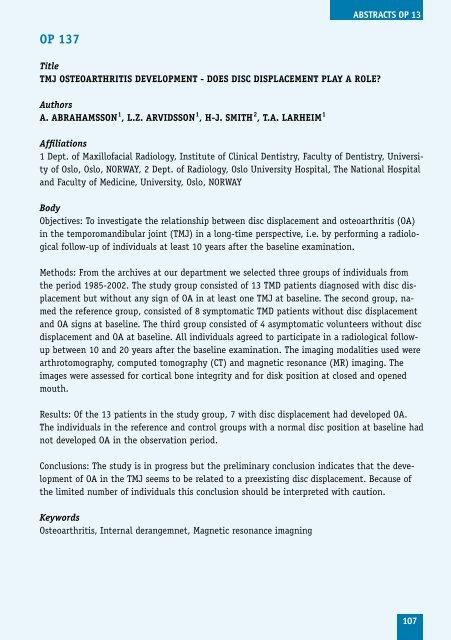Program including abstracts as pdf available here
Program including abstracts as pdf available here
Program including abstracts as pdf available here
Create successful ePaper yourself
Turn your PDF publications into a flip-book with our unique Google optimized e-Paper software.
OP 137<br />
Title<br />
TMJ OSTEOARTHRITIS DEVELOPMENT - DOES DISC DISPLACEMENT PLAy A ROLE?<br />
Authors<br />
A. AbRAHAMSSON 1 , L.z. ARVIDSSON 1 , H-J. SMITH 2 , T.A. LARHEIM 1<br />
aBSTracTS OP 13<br />
Affiliations<br />
1 Dept. of Maxillofacial Radiology, Institute of Clinical Dentistry, Faculty of Dentistry, University<br />
of Oslo, Oslo, NORWAY, 2 Dept. of Radiology, Oslo University Hospital, The National Hospital<br />
and Faculty of Medicine, University, Oslo, NORWAY<br />
Body<br />
Objectives: To investigate the relationship between disc displacement and osteoarthritis (OA)<br />
in the temporomandibular joint (TMJ) in a long-time perspective, i.e. by performing a radiological<br />
follow-up of individuals at le<strong>as</strong>t 10 years after the b<strong>as</strong>eline examination.<br />
Methods: From the archives at our department we selected three groups of individuals from<br />
the period 1985-2002. The study group consisted of 13 TMD patients diagnosed with disc displacement<br />
but without any sign of OA in at le<strong>as</strong>t one TMJ at b<strong>as</strong>eline. The second group, named<br />
the reference group, consisted of 8 symptomatic TMD patients without disc displacement<br />
and OA signs at b<strong>as</strong>eline. The third group consisted of 4 <strong>as</strong>ymptomatic volunteers without disc<br />
displacement and OA at b<strong>as</strong>eline. All individuals agreed to participate in a radiological followup<br />
between 10 and 20 years after the b<strong>as</strong>eline examination. The imaging modalities used were<br />
arthrotomography, computed tomography (CT) and magnetic resonance (MR) imaging. The<br />
images were <strong>as</strong>sessed for cortical bone integrity and for disk position at closed and opened<br />
mouth.<br />
Results: Of the 13 patients in the study group, 7 with disc displacement had developed OA.<br />
The individuals in the reference and control groups with a normal disc position at b<strong>as</strong>eline had<br />
not developed OA in the observation period.<br />
Conclusions: The study is in progress but the preliminary conclusion indicates that the development<br />
of OA in the TMJ seems to be related to a preexisting disc displacement. Because of<br />
the limited number of individuals this conclusion should be interpreted with caution.<br />
Keywords<br />
Osteoarthritis, Internal derangemnet, Magnetic resonance imagning<br />
107


